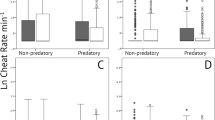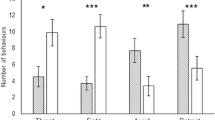Abstract
A growing body of evidence suggests that the costs and benefits involved in cleaning interactions can vary over space and time depending on the environmental conditions. However, whether the same cleaners actually induce variable net outcomes in terms of host fitness remains unclear to date. Branchiobdellid annelids are generally regarded as commensals or rarely parasites of their freshwater crayfish hosts, but a recent study suggests that they may also function as cleaning organisms. Under natural conditions, crayfish can experience fouling of the exposed surfaces of their exoskeletons and their gills (e.g., epibiosis) by various epibionts and particles of organic debris, and branchiobdellids graze on these sources of fouling. Here, we examined the extent to which variation in fouling pressure in the environment alters the outcome of the interaction between branchiobdellids and their crayfish host Cambaroide similis. A series of manipulations were performed in artificial environments designed to simulate either high or low fouling pressure. We used crayfish growth rates and mortality as direct measurements of the net costs and benefits of cleaning. Branchiobdellids had no significant effect on crayfish growth or mortality when cultured under low fouling pressure. However, their presence had a significant positive impact on host growth rates when cultured under high fouling pressure. These results suggest that the relationship between crayfish and branchiobdellids can fluctuate between commensalism and mutualism depending mainly on the environmental fouling pressure. We hypothesize that the outcome of cleaning interactions may largely depend on the factors directly related to the need for cleaning, such as parasite loads or fouling pressure.


Similar content being viewed by others
References
Bansemer C, Grutter AS, Poulin R (2002) Geographic variation in the behaviour of the cleaner fish Labroides dimidiatus (Labridae). Ethology 108:353–366
Bauer RT (1989) Decapod crustacean grooming: functional morphology, adaptive value, and phylogenetic significance. In: Felgenhauer BE, Watling L, Thistle AB (eds) Functional morphology of feeding and grooming. A.A. Balkema, Rotterdam, pp 49–73
Bauer RT (1998) Gill-cleaning mechanisms of the crayfish Procambarus clarkii (Astacidea : Cambaridae): experimental testing of setobranch function. Invertebr Biol 117:129–143
Bauer RT (2002) The ineffectiveness of grooming in prevention of body fouling in the red swamp crayfish, Procambarus clarkii. Aquaculture 208:39–49
Bishop JE (1968) An ecological study of the branchiobdellid commensals of some mid-western Ontario crayfish. Can J Zool 46:835–843
Breton LM, Addicott JF (1992) Density-dependent mutualism in an aphid–ant interaction. Ecology 73:2175–2180
Brinkhurst RO, Gelder SR (2001) Annelida: Oligochaeta including the Branchiobdellidae. In: Thorpe JH, Covitch F (eds) Ecology and classification of North American freshwater invertebrates, 2nd edn. Academic Press, New York, pp 431–463
Bristow CM (1984) Differential benefits from ant attendance to two species of Homoptera on New York ironweed. J Anim Ecol 53:715–726
Bronstein JL (1994) Conditional outcomes in mutualistic interactions. Trends Ecol Evol 9:214–217
Bronstein JL, Barbosa P (2002) Multi-trophic/multispecies mutualistic interactions: the role of non-mutualists in shaping and mediating mutualisms. In: Tscharntke T, Hawkins B (eds) Multitrophic level interactions. Cambridge University Press, Cambridge, pp 44–65
Brown BL, Creed RP (2004) Host preference by an aquatic ectosymbiotic annelid on two sympatric species of host crayfishes. J North Am Benthol Soc 23:90–100
Brown BL, Creed RP, Dobson WE (2002) Branchiobdellid annelids and their crayfish hosts: are they engaged in a cleaning symbiosis? Oecologia 132:250–255
Buckley RC, Gullan P (1991) More aggressive ant species (Hymenoptera: Formicidae) provide better protection for soft scales and mealybugs (Homoptera: Coccidae, Pseudococcidae). Biotropica 23:282–286
Cheney KL, Côté IM (2005) Mutualism or parasitism? The variable outcome of cleaning symbioses. Biol Lett 1:162–165
Creed RP Jr (1994) Direct and indirect effects of crayfish grazing in a stream community. Ecology 75:2091–2103
Cushman JH (1991) Host–plant mediation of insect mutualisms: variable outcomes in herbivore–ant interactions. Oikos 61:138–144
Cushman JH, Addicott JF (1991) Conditional interactions in ant–plant–herbivore mutualisms. In: Huxley CR, Cutler DF (eds) Ant–plant interactions. Oxford University Press, Oxford, pp 92–103
Cushman JH, Whitham TG (1989) Conditional mutualism in a membracid–ant association: temporal, age-specific, and density-dependent effects. Ecology 70:1040–1047
Englund G, Krupa JJ (2000) Habitat use by crayfish in stream pools: influence of predators, depth and body size. Freshw Biol 43:75–83
Gaume L, McKey D, Terrin S (1998) Ant–plant–homopteran mutualism: how the third partner affects the interaction between a plantspecialist ant and its myrmecophyte host. Proc R Soc Lond B 265:569–575
Gehring CA, Whitham TG (1991) Herbivore-driven mycorrhizal mutualism in insect-susceptible pinyon pine. Nature 353:556–557
Gelder SR (1999) Zoogeography of branchiobdellidans (Annelida) and temnocephalans (Platyhelminthes) ectosymbiotic on freshwater crustaceans, and their reactions to one another in vitro. Hydrobiologia 406:21–31
Gelder SR, Brinkhurst RO (1990) An assessment of the phylogeny of the branchiobdellida (Annelida: Clitellata), using PAUP. Can J Zool 68:1318–1326
Gelder SR, Messick G (2006) First report of the aberrant association of branchiobdellidans (Annelida: Clitellata) on blue crabs (Crustacea: Decapoda) in Chesapeake Bay, Maryland, USA. Invertebr Biol 125:51–55
Gelder SR, Smith RC (1987) Distribution of branchiobdellids (Annelida: Clitellata) in Northern Maine, USA. Trans Am Microsc Soc 106:85–88
Grabda E, Wierzbicka J (1969) The problem of parasitism of the species of genus Branchiobdella Odier, 1823. Pol Arch Hydrobiol 16:93–104
Holt PC (1963) A new branchiobdellid (Branchiobdellidae: Cambarincola). J Tenn Acad Sci 38:97–100
Huner JV, Barr JE (1991) Red swamp crayfish: biology and exploitation, 3rd edn. Louisiana Sea Grant College Program, Centre for Wetland Resources, Louisiana State University, Baton Rouge
Janzen DH (1966) Coevolution of mutualism between ants and acacias in Central America. Evolution 20:249–275
Jennings JB, Gelder SR (1979) Gut structure, feeding and digestion in the branchiobdellid oligochaete Cambarincola macrodonta Ellis 1912, an ectosymbiote of the freshwater crayfish Procambarus clarkii. Biol Bull 156:300–314
Keller TA (1992) The effect of the branchiobdellid annelid Cambarincola fallax on the growth rate and condition of the crayfish Orconectes rusticus. J Freshw Ecol 7:165–170
Kersch MF, Fonseca CR (2005) Abiotic factors and the conditional outcome of an ant–plant mutualism. Ecology 86:2117–2126
Koepp SJ (1975) Effects of host ecdysis on population structure of the epizootic branchiobdellid Cambarincola vitrea (Annelida: Oligochaeta). Sci Biol J 1:39–42
Losey GS (1972) The ecological importance of cleaning symbiosis. Copeia 1972:820–833
Losey GS (1987) Cleaning symbiosis. Symbiosis 4:229–258
Maiorana VC (1979) Nontoxic toxins: the energetics of coevolution. Biol J Linn Soc 11:387–396
McManus LR (1960) Some ecological studies of the Branchiobdellidae (Oligochaeta). Trans Am Microsc Soc 79:420–428
Nyström P, Stenroth P, Holmqvist N, Berglund O, Larsson P, Granéli W (2006) Crayfish in lakes and streams: individual and population responses to predation, productivity and substratum availability. Freshw Biol 51:2096–2113
Pierce N, Braby MF, Heath A, Lohman DJ, Mathew J, Rand DB, Travassos MA (2002) The ecology and evolution of ant association in the Lycaenidae (Lepidoptera). Annu Rev Entomol 47:733–771
Poulin R, Grutter AS (1996) Cleaning symbioses: proximate and adaptive explanations. BioScience 46:512–517
Rico-Gray V, Garcia-Franco JG, Palacios-Rios M, Diaz-Castelazo C, Parra-Tabla V, Navarro JA (1998) Geographical and seasonal variation in the richness of ant–plant interactions in México. Biotropica 30:190–200
Setala H, Rissanen J, Markkola AM (1997) Conditional outcomes in the relationship between pine and ectomycorrhizal fungi in relation to biotic and abiotic environment. Oikos 80:112–122
Sokal RR, Rohlf FJ (1995) Biometry. The principles and practice of statistics in biological research, 3rd edn. Freeman, New York
Stachowicz JJ, Hay ME (1999) Mutualism and coral persistence: the role of herbivore resistance to algal chemical defense. Ecology 80:2085–2101
Stein RA (1977) Selective predation, optimal foraging, and the predator–prey interaction between fish and crayfish. Ecology 58:1237–1253
Stevenson JR (1985) Dynamics of the integument. In: Bliss DE, Mantel LH (eds) The biology of Crustacea, vol 9. Academic Press, New York, pp 1–42
Subchev MA (1986) On the Korean branchiobdellids (Annelida, Clitellata) with a description of a new species-Branchiobdella teresae sp.n. Acta Zool bulg 31:60–66
Thompson JN (1982) Interaction and coevolution. Wiley, New York
Thompson JN (1988) Variation in interspecific interactions. Annu Rev Ecol Syst 19:65–87
Timm T (1991) Branchiobdellida (Oligochaeta) from the farthest South-East of the U.S.S.R. Zool Scr 20:321–331
van Ommeren RJ, Thomas G, Whitham TG (2002) Changes in interactions between juniper and mistletoe mediated by shared avian frugivores: parasitism to potential mutualism. Oecologia 130:281–288
Wahl M (1989) Marine epibiosis I. Fouling and antifouling: some basic aspects. Mar Ecol Prog Ser 58:175–189
Yamaguchi H (1934) Studies on Japanese Branchiobdellidae with some remarks on the classification. J Fac Sci Hokkaido Imp Univ, ser 6 (zool) 3:177–219
Young W (1966) Ecological studies of the Branchiobdellidae (Oligochaeta). Ecology 47:571–578
Acknowledgments
We are very thankful to Zhen Zhu, Na Ahn, Sae Heon Chung for their assistance in the field and laboratory work. We also thank Gi Sik Min, Tarmmo Timm and Mitko Subchev for providing valuable information on Korean branchiobdellids. We especially thank Dr. Yong-Hak Kim at the School of Biological Sciences, Seoul National University, for conducting the epifluorescent microscopy and Stuart Gelder for providing helpful comments on the manuscript and confirming the identification of Korean branchiobdellids. This manuscript was greatly improved by valuable comments and suggestions from Bryan Brown and Susan Lappan. We also give thanks to Tae Won Lee for inspiring the study and Jong Yeol Moon for providing important suggestions throughout the study. J.C. Choe was funded by Ewha Womans University. The experiment and methodology in this study comply with current laws of Republic of Korea.
Author information
Authors and Affiliations
Corresponding author
Additional information
Communicated by Carla Caceres.
Rights and permissions
About this article
Cite this article
Lee, J.H., Kim, T.W. & Choe, J.C. Commensalism or mutualism: conditional outcomes in a branchiobdellid–crayfish symbiosis. Oecologia 159, 217–224 (2009). https://doi.org/10.1007/s00442-008-1195-7
Received:
Accepted:
Published:
Issue Date:
DOI: https://doi.org/10.1007/s00442-008-1195-7




